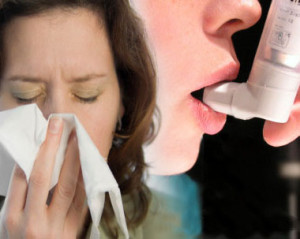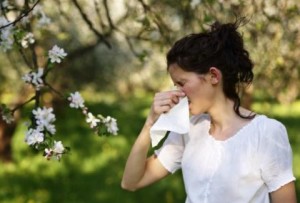 Asthma and allergies are related to each other in a way, kind of like cousins or in-laws. There is even a particular type of asthma called allergic asthma or sometimes referred to as extrinsic asthma. This is usually brought on when a person comes in contact with a common allergen like pet dander or pollen as suffers an allergic reaction.
Asthma and allergies are related to each other in a way, kind of like cousins or in-laws. There is even a particular type of asthma called allergic asthma or sometimes referred to as extrinsic asthma. This is usually brought on when a person comes in contact with a common allergen like pet dander or pollen as suffers an allergic reaction.
Generally, a person who battles bouts of allergic asthma has a family and/or personal medical history of allergies, such as hay fever, eczema (a skin irritation that can bring about a red rash, small blisters and a lot of itching) or allergic rhinitis. When someone has an allergic asthma attack, his or her air passageway from the mouth or nose becomes obstructed and inflamed. These symptoms, while uncomfortable and in many cases painfully frightening, can typically be subdued with medicine.
Of the more than 20 million people with asthma, more than 50 percent of them suffer from allergic asthma according to the American Academy of Allergy, Asthma and Immunology making it the most common type of asthma. More than 2.5 million children younger than 18 years of age are battling this type of asthma.
Allergic asthma is just one of the many types of asthma. Other forms of this debilitating affliction are exercise-induced asthma, nocturnal asthma, asthma in pregnancy, occupational asthma, seasonal asthma and non-allergic asthma.

Non-allergic asthma and allergic asthma are sometimes difficult to tell apart. They share many of the same symptoms, such as wheezing, coughing, a shortness of breath or rapid breathing and a tightening of the chest. The main difference between the two is that, as mentioned above, allergic asthma requires that the person come into contact with an allergen, like dust mites, pollen, mold or pet dander for an attack to be triggered in him or her.
A non-allergic asthma sufferer need not have allergies in order to bring on an asthma attack. These attacks can be kicked off or made worse by contact with non-allergic asthma triggers. Irritants in the air the person breathes, such as tobacco smoke, pine odors, room deodorizers, wood smoke, fresh paint, cooking orders, household cleaning products, perfumes and outdoor air pollution can all cause or heighten the symptoms of an asthma attack. Other potential attack causes can be respiratory infections such as the flu, sinus infections and the common cold have all been known to bring on asthma symptoms. A final category of asthma triggers are exercise, cold air gastroesophageal reflux (also known as heartburn) and sudden air temperature fluctuations.
 Asthma’s cousin or at least associate, allergies, come in a multitude of unpleasant shapes and sizes, so to speak. These combustible diseases attack the afflicted person’s immune system when he or she is near or touches an allergen, the aforementioned substances known to cause allergy attacks.
Asthma’s cousin or at least associate, allergies, come in a multitude of unpleasant shapes and sizes, so to speak. These combustible diseases attack the afflicted person’s immune system when he or she is near or touches an allergen, the aforementioned substances known to cause allergy attacks.
Allergies are classified according to the types of symptoms, types of triggers or the location of the symptoms on the sufferer’s body. Some of the most common allergies are food and drug allergies, latex allergies, insect allergies, eye allergies, skin allergies and indoor and outdoor allergies (often referred to as hay fever, seasonal, perennial or nasal allergies).
Living with allergies and asthma can be an unrelenting, painful and crippling life, but it doesn’t have to be. There are countless resources, especially on the Internet, where people afflicted with allergies and asthma can go to learn tips, home remedies, preventive measures, remedies to aid in sleep and discovering hidden or unexpected allergens.
